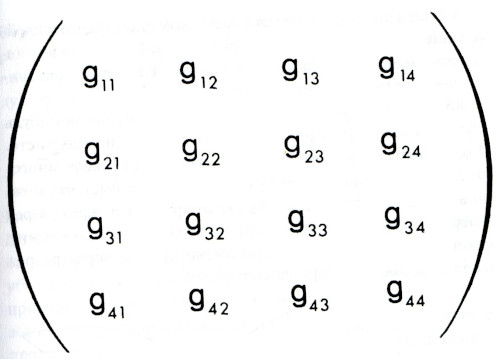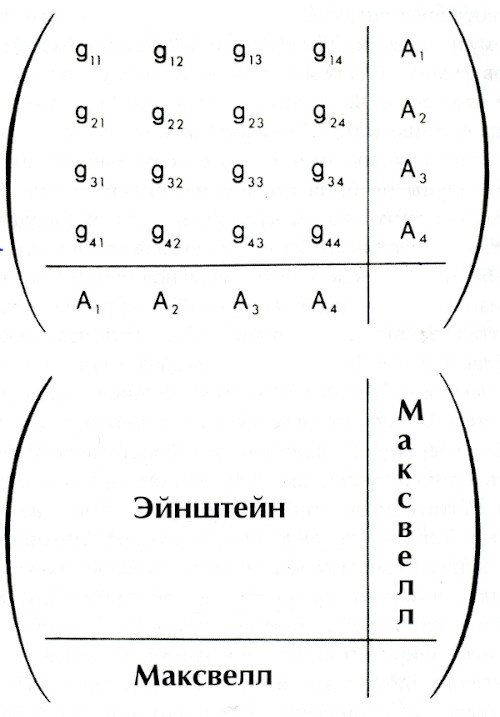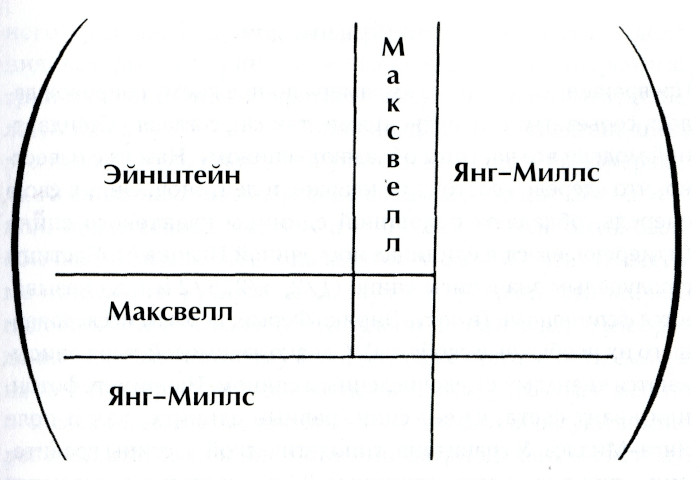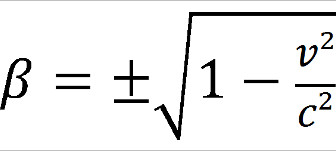In 1921, the Polish physicist Theodor Kaluza proposed a mathematical model, in which gravitation in located simultaneously in two spaces: in three dimensional space (where it is an ordinary force of gravity) and in four dimensional space (where it takes the form of electromagnetism). By allowing this (the «polydimensionality» of gravity) we get a mathematical miracle: the world contains only gravitation (this is the ideal of the Grand Unified Field Theory), while that which we call electromagnetism is its component in the fourth dimension [Davis, 1989, pp. 163-164]. Kaluza effectively used a specific example of transdimensionalism («polydimensionality» PD), in which a single object is located in spaces of different dimensions, in general it’s located in spaces of dimensionality N and N+1 (N+K). But this is not all. Let us examine Kaluza’s theory further. There is a concept known as the «Riemann metric tensor», which Einstein used in his Theory of Relativity [Kaku, 2014, p.75, see Fig. 4].
МЕТРИЧЕСКИЙ ТЕНЗОР РИМАНА (Riemann metric tensor)
Figure 4
Three spatial coordinates and one time coordinate form our four dimensional space. Each point in this space in fixated using a set of parameters inside of a component of the metric tensor, written in the form of a four dimensional matrix. The matrix describes Einstein’s field of gravitation. Maxwell’s electromagnetic field also has its own set of parameters, which have nothing to do with gravity. Kaluza discovered, that Maxwell’s field fits perfectly into Riemann’s tensor, if one moves into the fifth dimension (a transdimensional transition). In Figure 5, four rows and columns of the matrix are related to Einstein’s field, while the fifth row and column are related to Maxwell’s field.
M
Einstein a
x
w
e
l
l
Maxwell
Figure 5
Light and gravity have been united [Kaku, 2014, p.155]! However, after this, two new fundamental forces (weak and strong force) were discovered, and Kaluza’s theory moved to the background, and was considered a «mathematical trick». It gained a renewed interest in modern times, after the creation of the Yang-Mills theory, which describes the strong and weak forces. Suddenly, it was discovered that, if one adds five dimensions (five rows and columns) to the five dimensional Einstein-Maxwell tensor, the resulting ten dimensional tensor fits perfectly into the Yang-Mills field [Kaku, 2014, p.207]. The transdimensional transition into higher dimensions brought us to the long sought after Grand Unification of all four forces (see Fig.6).
M
Einstein a
x
w Yang-Mills
e
l
Maxwell l
Yang-Mills
Fugure 6
What, then, lies behind this «mathematical miracle»? In reality, the mathematics found: 1) an ideal way of fitting subspaces into a whole, 2) a strong interaction between these inserted spaced (a so called «super force» — another attribute of the Grand Unification, [Davis, 1989, Koblyakov, 2015]) — this is a manifestation of the very same transdimensional stratification, which takes on the guise of different forces in subspaces of different dimensions.
Another example of aesthetic modeling in physics deals with both the evaluation and the prediction of a scientific discovery. Let us remember the pair «language-speech». Speech is located in a higher dimensional space relative to language. As we have already shown, the way to get there is through negation, which «launches» the transdimensional transition. By separating «physics-speech» from «physics-language», we can predict that in physics, the negating elements in mathematical formulas contain new «hidden» physical results, which create a new worldview. One such example is the work of Paul Dirac — his formula for the energy of an electron has two solutions: one is positive, the other is negative. Negative solutions in nonlinear equations are usually discarded (disjunction), but Dirac did not discard it (conjunction), this led him to predict the existence of a partner for normal electrons, which he called an «antielectron», whose existence was experimentally proven several years later (as the «positron»). A transdimensional transition from disjunction to conjunction has occurred, and through this, together with negation, (see earlier «negation as a precondition of creativity») physics acquired the concept of antimatter… Other famous equations with negative solution are still waiting to be studied (see Fig. 7, the equations of Lorenz and Einstein). And then, into our existing physical worldview will enter a space «beyond» the lights barrier which, in fact, has mental properties.
E= ± mc²
Figure 7
A new approach focuses on joint efforts of scientists from different fields, and subsequently will require a simultaneous effort of many scientist working in several fields, which, in the end, will lead to the creation of a new super science («Uniology», in our terminology). If all existing sciences examine the world piece by piece, then Uniology will look at it as an inseparable whole, this will be a grandiose act of creative synthesis, happening in different types of material using the same scheme — «from disjunction to conjunction»!
It’s easy to see, that aesthetic modeling is based on a method of analogy. So, how reliable is it? It is as reliable as modeling as a whole, which is based on comparison. If initially the terms of any field of study correctly fixate the categories of meaning, goal, integrity, and value, then the meaning of this kind of work goes beyond the framework of the basic disciple, and inevitably become a multi disciplinary endeavor, which, by definition assumes the use of analogy. And let us offer one final argument in favor of this method, as the only possible one in the given conditions. We have come into a world which was not created by us. Many stages of its development are not reproducible, and many of its mysteries are unattainable to us. Here we can recall Plato’s cave, inside which we are doomed to never understand what is happening outside the cave. But there is a way out: we can understand the mysteries of the physical world, which was not created by us, if we understand the universal laws of creativity and our own creative process beyond that which is reflexive: how we create our inner world is also, hypothetically, how the outside world was created! The problem is only in finding an adequate replacement model. And, who knows, to what extent is it accidental that, seemingly, different phenomena (physical and musical) are referred to by the same word –“gravitation (gravity)» (see Martin Heidegger: «Language is smarter than us»)!
References
Beskova I.A. (1993). How is Creative Thinking Possible. Moscow (In Russian).
Davis P. (1989).Superpower. Мoscow (In Russian).
Каку М. (2014). Hyperspace. Moscow (In Russian)
Koblyakov A.A. (2000a). From Disjunction to Conjunction (The Contours of a New Theory of Art) // Languages of Science — Languages of Art. Moscow ( In Russian).
Koblyakov A.A. (2000b). The Theorem of Transdimensional Transition // The Works of the International «Mathematics. Computers. Education», Conference Moscow-Dubna ( In Russian).
Koblyakov A.A. (1997). The Discrete and Continuous in Music from the Point of View of a Problem-Essence Oriented Approach // The Works of the International «Mathematics and Art» Conference. Moscow ( In Russian).
Koblyakov A.A. (2003). On the Single Model, Explaining Art in its most Broad Understanding // “Stable Development, Science and Practice”, No. 2, Moscow-Dubna (In Russian).
Koblyakov A. A. (1995). Semantic Aspects of Self-similarity in Music // Symmetry: Culture and Science, Volume 2, Number 2.
Koblyakov A. A. (2015). Creation and new transdimensional relations // Symmetry: culture and science, volume 26, number 3.
Nalimov V.V. (1989). The Spontaneity of Consciousness. Moscow (In Russian).
Sosnin E.A., Poyzner B.H. (1997). A Laser Model of Art. Moscow ( In Russian).




